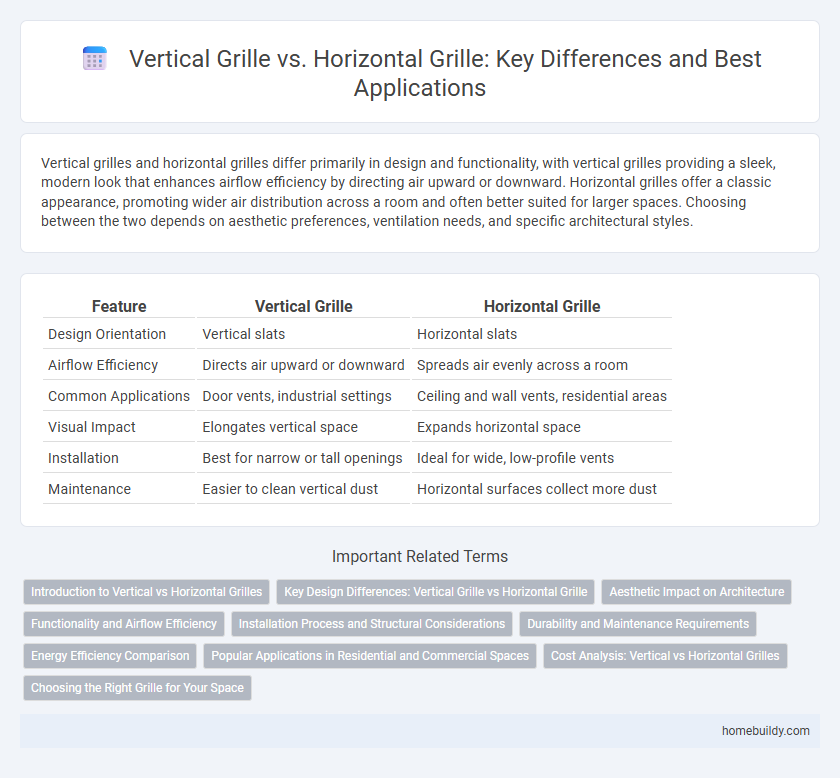Vertical grilles and horizontal grilles differ primarily in design and functionality, with vertical grilles providing a sleek, modern look that enhances airflow efficiency by directing air upward or downward. Horizontal grilles offer a classic appearance, promoting wider air distribution across a room and often better suited for larger spaces. Choosing between the two depends on aesthetic preferences, ventilation needs, and specific architectural styles.
Table of Comparison
| Feature | Vertical Grille | Horizontal Grille |
|---|---|---|
| Design Orientation | Vertical slats | Horizontal slats |
| Airflow Efficiency | Directs air upward or downward | Spreads air evenly across a room |
| Common Applications | Door vents, industrial settings | Ceiling and wall vents, residential areas |
| Visual Impact | Elongates vertical space | Expands horizontal space |
| Installation | Best for narrow or tall openings | Ideal for wide, low-profile vents |
| Maintenance | Easier to clean vertical dust | Horizontal surfaces collect more dust |
Introduction to Vertical vs Horizontal Grilles
Vertical grilles feature slats oriented up and down, which enhances airflow direction and creates a modern aesthetic suited for tall spaces. Horizontal grilles have side-to-side slats, providing wider air distribution and complementing low-profile or wide installations. Choosing between vertical and horizontal grilles depends on architectural style, ventilation needs, and spatial dimensions.
Key Design Differences: Vertical Grille vs Horizontal Grille
Vertical grilles emphasize height and elegance by drawing the eye upward, enhancing the perception of space in narrow or tall areas. Horizontal grilles create a sense of width and stability, making rooms appear broader and grounded. The choice between vertical and horizontal grille design significantly influences architectural style, visual flow, and spatial perception.
Aesthetic Impact on Architecture
Vertical grilles create a sense of height and elegance, enhancing the perception of tall, slender architectural elements. Horizontal grilles emphasize width and stability, complementing modern and minimalist building designs. Choosing the grille orientation significantly influences the facade's visual rhythm and architectural balance.
Functionality and Airflow Efficiency
Vertical grilles excel in directing airflow upward or downward, enhancing ventilation in rooms with high ceilings, while horizontal grilles distribute air more evenly at mid-level, promoting balanced temperature control. The design of vertical grilles reduces air resistance, improving overall airflow efficiency in duct systems compared to some horizontal grille models. Choosing between vertical and horizontal grilles depends on specific HVAC layout and airflow requirements to maximize comfort and energy efficiency.
Installation Process and Structural Considerations
Vertical grilles typically require precise alignment during installation to ensure proper airflow and structural integrity, often involving secure mounting along wall studs or vertical supports. Horizontal grilles may be easier to install in ceiling or window applications due to their orientation but demand attention to maintaining level placement and secure fasteners to prevent sagging or distortion. Structural considerations for vertical grilles include load distribution along the vertical frame, while horizontal grilles must account for potential deflection under their own weight or external pressure.
Durability and Maintenance Requirements
Vertical grilles often offer enhanced durability due to better resistance against debris accumulation and easier water drainage, reducing corrosion risks. Horizontal grilles, while aesthetically versatile, typically require more frequent cleaning to prevent dirt buildup between the slats, increasing maintenance efforts. Choosing a vertical grille can lead to lower long-term upkeep costs and extended lifespan in harsh environmental conditions.
Energy Efficiency Comparison
Vertical grilles typically allow better airflow control by directing air upward or downward, which can enhance natural ventilation and reduce HVAC energy consumption. Horizontal grilles often distribute air more evenly across a room, potentially minimizing hotspots and improving overall energy efficiency in climate control. Selecting between vertical and horizontal grilles depends on the specific ventilation needs and energy goals of a building design.
Popular Applications in Residential and Commercial Spaces
Vertical grilles are commonly used in modern residential settings for their sleek, space-enhancing design that allows for effective airflow control in rooms with limited wall space. Horizontal grilles dominate commercial spaces such as offices and retail stores due to their ability to cover larger openings and facilitate even air distribution across wide areas. Both grille orientations contribute to optimizing HVAC performance while catering to specific architectural aesthetics and functional requirements.
Cost Analysis: Vertical vs Horizontal Grilles
Vertical grilles typically cost more than horizontal grilles due to increased material usage and installation complexity. Horizontal grilles benefit from standardized manufacturing processes that reduce labor expenses and minimize waste. When budgeting for ventilation or decorative applications, evaluating long-term maintenance and potential energy efficiency differences can also impact the overall cost-effectiveness between vertical and horizontal grille options.
Choosing the Right Grille for Your Space
Vertical grilles create a sense of height and can make low ceilings appear taller, ideal for smaller or vertically-oriented spaces, while horizontal grilles emphasize width and can make a room feel more expansive, perfect for wide walls and open areas. Consider the architectural style and room dimensions when selecting between vertical and horizontal designs, as vertical lines complement traditional and modern interiors, and horizontal lines suit contemporary and minimalist aesthetics. Choosing the right grille orientation enhances airflow efficiency and visual harmony, optimizing both function and design in your space.
vertical grille vs horizontal grille Infographic

 homebuildy.com
homebuildy.com